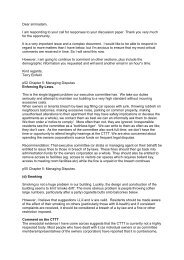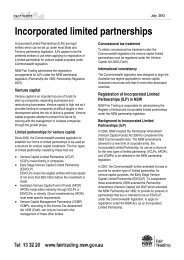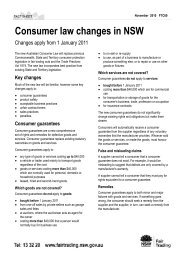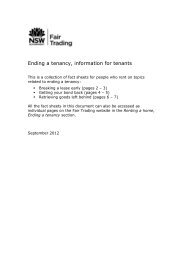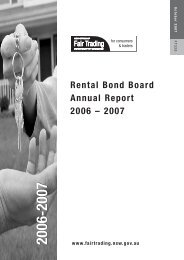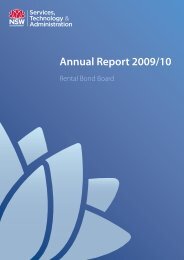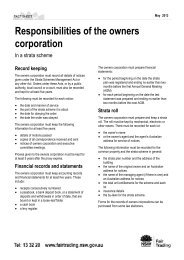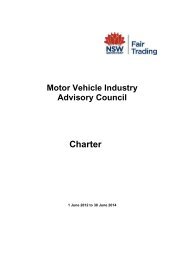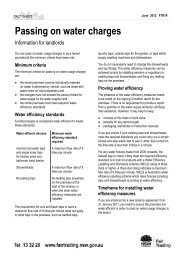High front guttering advisory committee report - NSW Fair Trading ...
High front guttering advisory committee report - NSW Fair Trading ...
High front guttering advisory committee report - NSW Fair Trading ...
You also want an ePaper? Increase the reach of your titles
YUMPU automatically turns print PDFs into web optimized ePapers that Google loves.
other such blockages that may occur over the operational life of the gutter. As a result,<br />
it was asserted by certain people presenting to the Committee that gutters should be<br />
designed with contingency for such events. Again, this assumption is wrong in meeting<br />
mandatory BCA performance requirements because the Code is silent on all durability<br />
issues including gutter maintenance. Such comments also seem ill founded because<br />
“notes” in the Standards (such as clauses 5.5.1 and 5.5.14 of AS3500.5) clearly state that<br />
the expectation is for regular maintenance and cleaning of gutters and that is the reason<br />
why such blockages are not accounted for in the stated design criteria. Even the instance<br />
concerning hail blockage (which is contained a normative section of the Standard)<br />
mentions that this only need be taken into account where hail occurs “frequently”.<br />
• Example 3: Six examples of provision for gutter overflow are provided in both AS3500.3<br />
and 3500.5. Of note, the location of this information varies in the two documents: one<br />
has it located in the Appendices and the other as “examples” within the normative<br />
section of the Standard. Standards Australia advised the Committee that in both<br />
instances, the information should be treated as “informative” only. In this context,<br />
these examples were often wrongly asserted by those presenting to the Committee as<br />
being the only mandatory means of providing gutter overflow compliance. This is<br />
incorrect as these examples should not be seen as being exclusive of other options –<br />
they are examples only. This situation also causes problems because most of the six<br />
examples do not appear to be regularly used by industry and most are not especially<br />
suited to contemporary high <strong>front</strong>ed gutter design. It was considered strange by the<br />
Committee that AS3500.3/3500.5 did not cater more for high <strong>front</strong>ed <strong>guttering</strong> given<br />
that this type of gutter is the most common in the market place. To some extent the<br />
above problem was found to be compounded by the fact that the same six examples<br />
have regularly been republished in brochures and circulars by other organisations, thus<br />
adding to the wrong perceptions mentioned above (refer Section 13 for details on this<br />
issue).<br />
10 Less Common Insights into Overflow Management – Where Does<br />
the Water Go?<br />
In deliberating on the previous commentary it was apparent to the Committee that a more<br />
measured an analytical approach to overflow (than in the current Deemed to Satisfy options) is<br />
desirable for ensuring the performance of high <strong>front</strong>ed <strong>guttering</strong>. As mentioned previously, this<br />
view was supported by the majority of those presenting to the <strong>committee</strong> including the gutter<br />
manufacturers themselves. To this end, it is worth structuring and to some extent cataloguing the<br />
various tested and informal measures of capacity and overflow relating to high <strong>front</strong>ed <strong>guttering</strong>:<br />
• In terms of gutter capacity, a senior technical hydraulic specialist within the <strong>NSW</strong><br />
Government Architect’s office made comment that gutter sizes in AS3500.3/3500.5 are<br />
conservative in sizing and that a more refined approach is available in the CSIRO’s 1973<br />
publication “Roof Drainage”, as authored by K.G. Martin. This point is supported by a<br />
hydraulic engineer specialising in roof drainage calculation who maintains a dedicated web<br />
site (http://www.roof-gutter-design.com.au/). He provides interesting information on<br />
gutter and downpipe “theory” where he states that “AS3500 does not take into account the<br />
23



